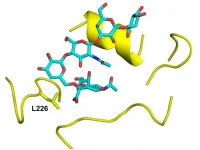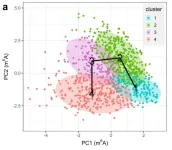(Press-News.org) LA JOLLA, CA—Avian influenza viruses typically require several mutations to adapt and spread among humans, but what happens when just one change can increase the risk of becoming a pandemic virus? A recent study led by scientists at Scripps Research reveals that a single mutation in the H5N1 “bird flu” virus that has recently infected dairy cows in the U.S. could enhance the virus’ ability to attach to human cells, potentially increasing the risk of passing from person to person. The findings—published in Science on December 5, 2024—highlight the need to monitor H5N1’s evolution.
Currently, there are no documented cases of H5N1 transmitting between people: bird flu cases in humans have been linked to close contact with contaminated environments as well as infected birds (including poultry), dairy cows and other animals. However, public health officials are concerned about the potential for the virus to evolve to transmit efficiently between humans, which could lead to a new, potentially deadly pandemic.
The flu virus attaches to its host via a protein called hemagglutinin that binds to glycan receptors on the surfaces of host cells. Glycans are chains of sugar molecules on cell surface proteins that can act as binding sites for some viruses. Avian (bird) influenza viruses like H5N1 primarily infect hosts with sialic acid-containing glycan receptors found in birds (avian-type receptors). While the viruses rarely adapt to humans, if they evolve to recognize sialylated glycan receptors found in people (human-type receptors), they could gain the ability to infect and possibly transmit between humans.
“Monitoring changes in receptor specificity (the way a virus recognizes host cells) is crucial because receptor binding is a key step toward transmissibility,” says Ian Wilson, DPhil, co-senior author and the Hansen Professor of Structural Biology at Scripps Research. “That being said, receptor mutations alone don’t guarantee that the virus will transmit between humans.”
Past cases in which avian viruses adapted to infect and transmit between people required multiple mutations, usually at least three. But for the H5N1 2.3.4.4b strain (A/Texas/37/2024) isolated from the first human infection with a bovine H5N1 virus in the United States, researchers found that just a single amino acid mutation in the hemagglutinin could switch specificity to binding human-type receptors. Here, bovine refers to the species for dairy cows that were the immediate source of the virus for the human infection. Importantly, the mutation wasn’t introduced into the whole virus—only the hemagglutinin protein to study its receptor-binding properties.
For their study, the research team introduced several mutations into the H5N1 2.3.4.4b hemagglutinin protein that had been involved in receptor specificity changes in previous avian viruses. These mutations were selected to mimic genetic changes that could occur naturally. When the team assessed the impact of one of these mutations, Q226L, on the virus’ ability to bind to human-type receptors, they found that that mutation significantly improved how the virus attached to glycan receptors, which represent those found in human cells.
“The findings demonstrate how easily this virus could evolve to recognize human-type receptors,” says first author Ting-Hui Lin, a postdoctoral associate at Scripps Research. “However, our study doesn’t suggest that such evolution has occurred or that the current H5N1 virus with only this mutation would be transmissible between humans.”
Instead, the research team focused on understanding how natural mutations, like Q226L, could arise and what their impact might be. To investigate the potential mutations that could enable the H5N1 2.3.4.4b hemagglutinin to attach to human receptors, the team used advanced binding assays in collaboration with the lab of co-senior author James Paulson, PhD, the Cecil H. and Ida M. Green Chair of Chemistry at Scripps Research. These assays, which are tests to mimic how well a virus attaches to a cell, allowed the researchers to precisely track how the altered H5N1 hemagglutinin interacted with human-type receptors.
“Our experiments revealed that the Q226L mutation could significantly increase the virus’ ability to target and attach to human-type receptors,” explains Paulson. “This mutation gives the virus a foothold on human cells that it didn’t have before, which is why this finding is a red flag for possible adaptation to people.”
The shift alone, however, may not be enough to enable human-to-human transmission. Other genetic changes—such as mutations in polymerase basic 2 (E627K) that enhance viral replication and stability in human cells—would likely be necessary for the virus to spread efficiently among people.
Nevertheless, given the rising number of H5N1 human cases stemming from direct contact with infected animals, the findings highlight the need for proactive surveillance of evolution in H5N1 and similar avian flu strains. While there’s no immediate cause for alarm, the researchers stress that even a single mutation that changes how H5N1 binds to human cells shouldn’t be overlooked.
“Continuing to track genetic changes as they happen will give us an edge in preparing for signs of increased transmissibility,” adds Wilson. “This type of research helps us understand what mutations to watch for and how to respond appropriately.”
In addition to Lin, Paulson and Wilson, authors of the study, “A Single Mutation in Bovine Influenza H5N1 Hemagglutinin Switches Specificity to Human Receptors,” include Xueyong Zhu, Shengyang Wang, Ding Zhang, Ryan McBride, Wenli Yu and Simeon Babarinde of Scripps Research.
This work was supported by funding from the National Institutes of Health NIAID Centers of Excellence for Influenza Research and Response contract 75N93021C00015 / PENN CEIRR.
"The content is solely the responsibility of the authors and does not necessarily represent the official views of the National Institutes of Health."
About Scripps Research
Scripps Research is an independent, nonprofit biomedical institute ranked one of the most influential in the world for its impact on innovation by Nature Index. We are advancing human health through profound discoveries that address pressing medical concerns around the globe. Our drug discovery and development division, Calibr-Skaggs, works hand-in-hand with scientists across disciplines to bring new medicines to patients as quickly and efficiently as possible, while teams at Scripps Research Translational Institute harness genomics, digital medicine and cutting-edge informatics to understand individual health and render more effective healthcare. Scripps Research also trains the next generation of leading scientists at our Skaggs Graduate School, consistently named among the top 10 US programs for chemistry and biological sciences. Learn more at www.scripps.edu.
END
Scripps Research scientists identify mutation that could facilitate H5N1 “bird flu” virus infection and potential transmission in humans
New findings underscore the importance of ongoing surveillance for H5N1 mutations that pose risks to public health.
2024-12-05
ELSE PRESS RELEASES FROM THIS DATE:
Queen Mary University of London vaccination tool boosts uptake of MMR vaccine in children
2024-12-05
A software tool developed by Queen Mary University of London’s Clinical Effectiveness Group (CEG) and used as part of a facilitated quality improvement programme has increased the number of children receiving their first MMR vaccination on time in North East London. The success of this programme highlights the potential of a learning health system and data-driven solutions to enhance public health and improve vaccination uptake across the UK.
An evaluation published in Vaccine revealed that the APL-Imms ...
Implantable sensors unlock ability to continuously monitor inflammation
2024-12-05
Implantable Sensors Unlock Ability to Continuously Monitor Inflammation
The Chan Zuckerberg Biohub Chicago’s milestone achievement tracks protein levels in real time, enabling monitoring of inflammation at the cellular level
Proteins are the building blocks of life, and changes in protein levels can indicate improving health or impending illness, including signs of inflammation. While protein levels can be measured in periodic blood or urine tests, it has been an uphill challenge to figure out how to continuously monitor protein levels in the human body in real time.
Now, a team of bioengineers at Chan Zuckerberg Biohub Chicago, supported by the ...
Buffalo besties: Feral female buffalo build friendships based on similar personality traits
2024-12-05
HONG KONG (29 November 2024)—Similar social personalities strongly influence friendships in humans, yet we know relatively little about how animals choose their friends.
But a new study by researchers at City University of Hong Kong (CityUHK) investigating a unique free-ranging feral population of water buffalo on Lantau Island in Hong Kong has discovered that close spatial proximity serves as an indicator of friendship based on the predictive patterns of certain personality traits.
“Our research provides evidence that friendships among water buffalo can form among individuals with similar behaviours. These findings ...
UNC researchers awarded up to $10M to leverage data science to accelerate cancer diagnosis and optimize delivery of precision oncology
2024-12-05
UNC researchers awarded up to $10M to leverage data science to accelerate cancer diagnosis and optimize delivery of precision oncology
CHAPEL HILL, North Carolina—A team of UNC-Chapel Hill researchers has been awarded up to $10 million in Advanced Research Projects Agency for Health (ARPA-H) funding to develop the Cancer Identification and Precision Oncology Center (CIPOC). The project is designed to improve cancer diagnosis and support personalized treatments by quickly aggregating and analyzing ...
Cardiovascular disease symptoms surprisingly high in young refugees
2024-12-05
Many individuals seeking asylum in the United States show increased stress and pain symptoms that are associated with indications of cardiovascular disease according to Weill Cornell Medicine researchers.
“We would not have expected the rates of these illnesses or conditions to be this high in such a young, otherwise healthy population,” said the study’s senior author, Dr. Gunisha Kaur, associate professor of anesthesiology and an anesthesiologist at NewYork-Presbyterian/Weill Cornell Medical Center.
The study, published Dec. 5 in Nature Mental Health, analyzed medical evaluations from 453 U.S. asylum seekers for symptoms associated with psychological ...
To remember conversations, keep making new brain cells
2024-12-05
Why do adults make new brain cells? A new study published in Cell Stem Cell provides the first cellular evidence that making new brain cells in adults supports verbal learning and memory, which enables people to have conversations and to remember what they hear. This discovery could point to new approaches to restore cognitive function.
The study, led by scientists from USC Stem Cell and the USC Neurorestoration Center at the Keck School of Medicine of USC, relied on brain tissue from patients with drug-resistant cases of mesial temporal lobe epilepsy (MTLE), which involves seizures as well as accelerated cognitive decline.
“Treating patients with epilepsy ...
RNA modifications in individual cells better understood with new modelling
2024-12-05
Researchers have developed a new tool that will help scientists study how genes are expressed in our cells. The tool, called SigRM, is used to analyse data from single-cell epitranscriptomics, a method for studying RNA modifications in individual cells. This research could lead to important insights into health and disease.
Recent advances in single-cell technology have enabled researchers to analyse thousands of individual cells at once, providing rich information about the expression and activity of genes and proteins, as well as chemical changes that affect gene expression. A major tool in these studies is single-cell epitranscriptomics, which studies RNA ...
In five cancer types, prevention and screening have been major contributors to saving lives
2024-12-05
Improvements in cancer prevention and screening have averted more deaths from five cancer types combined over the past 45 years than treatment advances, according to a modeling study led by researchers at the National Institutes of Health (NIH). The study, published Dec. 5, 2024, in JAMA Oncology, looked at deaths from breast, cervical, colorectal, lung, and prostate cancer that were averted by the combination of prevention, screening, and treatment advances. The researchers focused on these five cancers because they are among the most common causes of cancer deaths and strategies ...
Estimation of cancer deaths averted from prevention, screening, and treatment efforts, 1975-2020
2024-12-05
About The Study: In this model-based study using population-level cancer mortality data, an estimated 5.94 million cancer deaths were averted for breast, cervical, colorectal, lung, and prostate cancers combined from 1975 to 2020. Prevention and screening accounted for 8 of every 10 averted deaths, and the contribution varied by cancer site. Despite progress, efforts to reduce the U.S. cancer burden will require increased dissemination of effective interventions and new technologies and discoveries.
Corresponding ...
Estimated reduction in health care spending associated with weight loss in adults
2024-12-05
About The Study: In this cross-sectional study, projected annual savings from weight loss among U.S. adults with obesity were substantial for both Medicare and employer-based insurance.
Corresponding Author: To contact the corresponding author, Kenneth E. Thorpe, PhD, email kthorpe@emory.edu.
To access the embargoed study: Visit our For The Media website at this link https://media.jamanetwork.com/
(doi:10.1001/jamanetworkopen.2024.49200)
Editor’s Note: Please see the article for additional information, including other authors, author contributions ...
LAST 30 PRESS RELEASES:
University of Oklahoma researcher awarded funding to pursue AI-powered material design
Exploring how the visual system recovers following injury
Support for parents with infants at pediatric check-ups leads to better reading and math skills in elementary school
Kids’ behavioral health is a growing share of family health costs
Day & night: Cancer disrupts the brain’s natural rhythm
COVID-19 vaccination significantly reduces risk to pregnant women and baby
The role of vaccination in maternal and perinatal outcomes associated with COVID-19 in pregnancy
Mayo Clinic smartwatch system helps parents shorten and defuse children's severe tantrums early
Behavioral health spending spikes to 40% of all children’s health expenditures, nearly doubling in a decade
Digital cognitive behavioral treatment for generalized anxiety disorder
Expenditures for pediatric behavioral health care over time and estimated family financial burden
Air conditioning in nursing homes and mortality during extreme heat
The Alps to lose a record number of glaciers in the next decade
What makes a good proton conductor?
New science reporting guide published for journalists in Bulgaria
New international study reveals major survival gaps among children with cancer
New science reporting guide published for journalists in Turkey
Scientists develop a smarter mRNA therapy that knows which cells to target
Neuroanatomy-informed brain–machine hybrid intelligence for robust acoustic target detection
Eight SwRI hydrogen projects funded by ENERGYWERX
The Lundquist Institute and its start-up company Vitalex Biosciences Announces Strategic Advancement of Second-Generation fungal Vaccine VXV-01 through Phase 1 Trials under $40 Million Competitive Con
Fine particles in pollution are associated with early signs of autoimmune disease
Review article | Towards a Global Ground-Based Earth Observatory (GGBEO): Leveraging existing systems and networks
Penn and UMich create world’s smallest programmable, autonomous robots
Cleveland researchers launch first major study to address ‘hidden performance killer’ in athletes
To connect across politics, try saying what you oppose
Modulating key interaction prevents virus from entering cells
Project explores barriers to NHS career progression facing international medical graduates
Jeonbuk National University researchers explore the impact of different seasonings on the flavor perception of Doenjang soup
Two Keck Medicine of USC Hospitals named Leapfrog Top Teaching Hospitals
[Press-News.org] Scripps Research scientists identify mutation that could facilitate H5N1 “bird flu” virus infection and potential transmission in humansNew findings underscore the importance of ongoing surveillance for H5N1 mutations that pose risks to public health.





